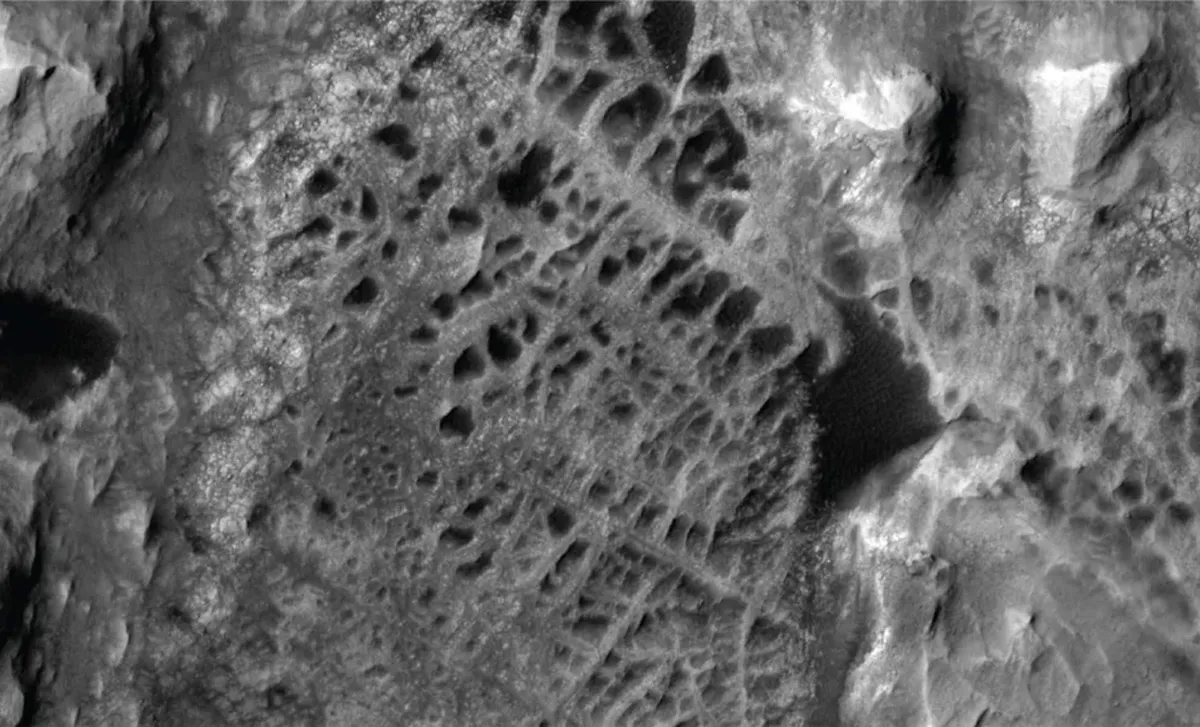
NASA's Curiosity Mars rover has achieved a remarkable milestone by capturing the first-ever detailed images of gigantic Martian spiderwebs. These intricate, zig-zagging ridges, remnants of ancient groundwater processes, could provide vital insights into Mars' watery history and offer clues about the possibility of extraterrestrial life on the Red Planet. Researchers are eager to understand these unique formations, which are known as boxwork.
The boxwork formations consist of criss-crossing ridges made from mineral-rich rocks that sporadically appear on the Martian surface. These patterns can extend up to 12 miles (20 kilometers) and resemble webbing spun by colossal arachnids when viewed from space. Until now, these fascinating structures had not been closely studied, making this recent exploration a significant advancement in Martian geology.
On Earth, smaller boxwork formations can be found on cave walls and develop through a process similar to that of stalagmites and stalactites. Scientists believe that a similar geological mechanism may have formed these structures on Mars, albeit on a much grander scale. The bedrock beneath these ridges likely originated from groundwater seeping through the rock, leaving behind minerals that accumulated in cracks and fissures, eventually hardening into a cement-like substance. Eons of Martian wind erosion have stripped away the softer rock, revealing the resilient mineral ridges beneath.
Curiosity is currently investigating a cluster of boxwork formations on the slopes of the towering Mount Sharp, which rises 3.4 miles (5.5 kilometers) high within the Gale Crater. The rover, which landed on Mars in 2012, embarked on its journey to this area in November 2024 and arrived earlier this month. The boxwork formations are a primary focus for mission scientists, as these unique ridges are not found elsewhere on the mountain, raising questions about their origin.
On June 23, NASA unveiled the first close-up images of these faux spiderwebs, accompanied by an interactive video on their YouTube channel that allows viewers to explore the site in 3D. In addition, the rover drilled and analyzed surrounding rock samples, discovering veins of calcium sulfate, a mineral commonly associated with groundwater. This mineral has not been previously observed at such high elevations on Mount Sharp, making its discovery particularly intriguing. Abigail Fraeman, Curiosity’s deputy project scientist at NASA's Jet Propulsion Laboratory, emphasized the significance of this finding in a recent statement.
By studying the boxwork formations closely, researchers aim to unlock more secrets about Mars' historical connection to water, particularly before its oceans were stripped away by solar radiation. Future discoveries could also provide insights into a recently identified giant subsurface ocean hidden deep beneath the Martian crust.
Some scientists believe that the mineral ridges may help resolve ongoing debates regarding the potential for extraterrestrial life on Mars. The minerals crystallized underground, where conditions would have been warmer and salty liquid water could have flowed. According to Kirsten Siebach, a Curiosity mission scientist from Rice University in Houston, early Earth microbes thrived in similar environments, making these Martian ridges an exciting area for exploration.
As NASA continues its exploration of Mars, recent studies have revealed various intriguing phenomena, including visible auroras on the planet and even Martian volcanoes towering above the clouds. Each discovery contributes to our understanding of the Red Planet and its potential to have supported life.
As researchers delve deeper into the secrets of Mars' geology, the findings from the Curiosity rover's close-up study of the boxwork formations may pave the way for future missions aimed at uncovering the mysteries of our neighboring planet.